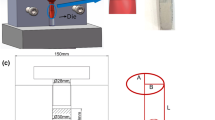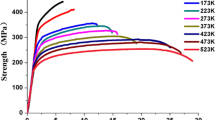Abstract
The effects of pre-twinning on the microstructure and dynamic compression properties of non-aged and artificially aged Mg–Y–Nd–Gd–Zr alloys were investigated in this study. Previous studies have shown that in the pre-deformed T3 alloy, precompression along the extrusion direction (ED) generates high-density < a > and < c + a > dislocations and deformation twins, such as the \(\left\{ {10\overline{1}2} \right\} < 10\overline{1}\overline{1} >\) extension, the \(\left\{ {10\overline{1}1} \right\} - \left\{ {10\overline{1}2} \right\}\) double, and \(\left\{ {10\overline{1}1} \right\} < 10\overline{1}\overline{2} >\) compression twins at 86°, 38°, and 56°, respectively. In the pre-deformed T8 alloy artificially aged at 200 °C for 12 h, the dislocation density was found to decrease, with β″ (Mg3Y0.85Nd0.15) and β′ (Mg12NdY) precipitates appearing at both ends of the twin boundary. Subsequently, the precipitates extended toward [0001]Mg and [0001]T in the matrix region and the twin, respectively. The orientation relationships (ORs) between the β″ and β′ precipitates and the matrix/twin were determined to be \(\left( {01\overline{1}0} \right)_{{\upbeta ^{\prime \prime } }} //\left( {000{1}} \right)_{{{\text{Mg}}/{\text{T}}}}\), \(\left[ {2\overline{1}\overline{1}0} \right]_{{\upbeta ^{\prime \prime } }} //\left[ {2\overline{1}\overline{1}0} \right]_{{{\text{Mg}}/{\text{T}}}}\) and (001)β′//(0001)Mg/T, \(\left[ {2\overline{1}\overline{1}0} \right]_{{\upbeta ^{\prime } }} //\left[ {2\overline{1}\overline{1}0} \right]_{{{\text{Mg}}/{\text{T}}}}\), respectively, in contrast to the counterpart ORs between the β″ and β′ precipitates and the matrix/twin in the non-deformed T61 alloy. Evaluation of the dynamic compression properties showed that compared with the compressive yield strength (CYS) of the T61 alloy, that of the T8 alloy considerably increased from 220 to 339 MPa. However, their ultimate compressive strengths (UCSs) of 363 and 360 MPa, respectively, were similar owing to the synergistic effect between the dislocations, the twin boundaries, and the precipitates. These results suggest that the pre-twinning approach should be adopted to improve the strengths of magnesium alloys.


















Similar content being viewed by others
Data and code availability
Data will be made available on request.
References
Silva EP, Buzolin RH, Marques F, Soldera F, Alfaro U, Pinto HC (2021) Effect of Ce-base mischmetal addition on the microstructure and mechanical properties of hot-rolled ZK60 alloy. J Magnes Alloys 9(3):995–1006
Malik A, Nazeer F, Naqvi SZH, Long JY, Li C, Yang Z, Huang YW (2022) Microstructure feathers and ASB susceptibility under dynamic compression and its correlation with the ballistic impact of Mg alloys. J Market Res 16:801–813
Malik A, Wang YW, Cheng HW, Nazeer F, Khan MA (2021) Post deformation analysis of the ballistic impacted magnesium alloys, a short-review. J Magnes Alloys 9(5):1505–1520
Malik A, Chaudry UM, Yan T, Long JY, Li C, Wang YW (2022) Achieving higher dynamic mechanical response by adjusting texture through twinning in a ZK61 Mg alloy. J Alloy Compd 902:163755
Xin YC, Wang MY, Zeng Z, Huang GJ, Liu Q (2011) Tailoring the texture of magnesium alloy by twinning deformation to improve the rolling capability. Scripta Mater 64(10):986–989
Malik A, Wang YW, Nazeer F, Khan MA, Ali T, Ain QT (2020) Effect of pre-straining on twinning, texture and mechanical behavior of magnesium alloys: a-review. J Market Res 9(6):14478–14499
Song B, Guo N, Liu TT, Yang QS (2014) Improvement of formability and mechanical properties of magnesium alloys via pre-twinning: a review. Mater Des 62:352–360
Malik A, Wang YW, Cheng HW, Nazeer F, Ahmed B, Khan MA, Wang MJ (2020) Constitutive analysis, twinning, recrystallization, and crack in fine-grained ZK61 Mg alloy during high strain rate compression over a wide range of temperatures. Mater Sci Eng A 771:138649
Koike J, Ohyama R (2005) Geometrical criterion for the activation of prismatic slip in AZ61 Mg alloy sheets deformed at room temperature. Acta Mater 53(7):1963–1972
Malik A, Wang YW, Cheng HW, Khan MA, Nazzer F, An R, Bao JW, Wang MJ (2019) Fracture behavior of twin induced ultra-fine grained ZK61 magnesium alloy under high strain rate compression. J Market Res 8(4):3475–3486
Kang YH, Wang XX, Zhang N, Yan H, Chen RS (2017) Effect of pre-deformation on microstructure and mechanical properties of WE43 magnesium alloy. Mater Sci Eng A 689:435–445
Jiang MG, Yan G, Chen RS (2015) Enhanced mechanical properties due to grain refinement and texture modification in an AZ61 mg alloy processed by small strain impact forging. Mater Sci Eng A 621:204–211
Lee JU, Kim YJ, Kim S-H, Lee JH, Kim M-S, Choi S-H, Moon BG, Kim MK, Park SH (2019) Texture tailoring and bendability improvement of rolled AZ31 alloy using 10 1 2 twinning: the effect of precompression levels. J Magnes Alloys 7(4):648–660
Yan CJ, Xin YC, Chen XB, Xu DK, Chu PK, Liu CQ, Guan B, Huang XH, Liu Q (2021) Evading strength-corrosion tradeoff in Mg alloys via dense ultrafine twins. Nat Commun 12(1):4616
Wang CP, Xin RL, Li DR, Song B, Wu MY, Liu Q (2017) Enhancing the age-hardening response of rolled AZ80 alloy by pre-twinning deformation. Mater Sci Eng, A 680:152–156
Zhang H, Yang MX, Hou MJ, Wang LF, Zhang Q, Fan JF, Li WG, Dong HB, Liu SM, Xu BS (2019) Effffect of pre-existing {101̄2} extension twins on mechanical properties, microstructure evolution and dynamic recrystallization of AZ31 Mg alloy during uniaxial compression. Mater Sci Eng A 744:456–470
Wang RF, Mao LP, Liu YY, Chen Y, Wang Z, Wang F, Zhou L, Liu Z (2019) Influence of pre-twinning on high strain rate compressive behavior of AZ31 Mg-alloys. Mater Sci Eng A 742:309–317
Xu YZ, Li JY, Qi MF, Liao LH, Gao ZJ (2020) Enhanced mechanical properties of Mg-Zn-Y-Zr alloy by low-speed indirect extrusion. J Market Res 9(5):9856–9867
Li AW, Li W, Luo M, Yu HM, Sun YD, Liang YL (2021) Effect of grain size on the microstructure and deformation mechanism of Mg-2Y-0.6Nd-0.6Zr alloy at a high strain rate. Mater Sci Eng A 824:141774
Zheng YF, Qin L, Yang K (2016) Degradable metal. Science press, Beijing
He SM, Zeng XQ, Peng LM, Gao X, Nie JF, Ding WJ (2007) Microstructure and strengthening mechanism of high strength Mg–10Gd–2Y–0.5Zr alloy. J Alloy Compd 427(1–2):316–323
Sandlöbes S, Friák M, Zaefferer S, Dick A, Yi S, Letzig D, Pei Z, Zhu L-F, Neugebauer J, Raabe D (2012) The relation between ductility and stacking fault energies in Mg and Mg–Y alloys. Acta Mater 60(6–7):3011–3021
Asgari H, Szpunar JA, Odeshi AG, Zeng LJ, Olsson E (2015) Effect of grain size on high strain rate deformation of rolled Mg–4Y–3RE alloy in compression. Mater Sci Eng A 633:92–102
Nie JF, Muddle BC (1999) Precipitation in magnesium alloy WE54 during isothermal ageing at 250 °C. Scripta Mater 40(10):1089–1094
Nie JF, Muddle BC (2000) Characterisation of strengthening precipitate phases in a Mg-Y-Nd alloy. Acta Mater 48(8):1691–1703
Zhang WG, Liu S, Li K, Li PJ, Qi JF, Wang Z, Chen Y, Zhang HS, Li M (2018) High strain-rate behavior and deformation mechanism of a multi-layer composite textured AZ31B Mg alloy plate. J Alloy Compd 749:23–39
Hansen N (2004) Hall-Petch relation and boundary strengthening. Scripta Mater 51(8):801–806
Bata V, Pereloma EV (2004) An alternative physical explanation of the Hall-Petch relation. Acta Mater 52(3):657–665
Gao L, Chen RS, Han EH (2009) Effects of rare-earth elements Gd and Y on the solid solution strengthening of Mg alloys. J Alloy Compd 481(1–2):379–384
Antion C, Donnadieu P, Tassin C, Pisch A (2006) Early stages of precipitation and microstructure control in Mg–rare earth alloys. Phil Mag 86(19):2797–2810
Rokhlin LL (2003) Magnesium alloys containing rare earth metals: structure and properties. CRC Press, Florida
Zhang Y, Liu T, Ding X, Xu S, He J, Chen H, Pan FS (2014) The precipitation behavior of a pretwinned Mg–6Al–1Zn alloy and the effect on subsequent deformation. J Mater Res 29(18):2141–2146
Nie JF, Zhu YM, Liu JZ, Fang XY (2013) Periodic Segregation of Solute Atoms in Fully Coherent Twin Boundaries. Science 340(6135):957–960
Wan YJ, Zeng Y, Dou YC, Hu DC, Qian XY, Zeng Q, Sun KX, Quan GF (2022) Improved mechanical properties and strengthening mechanism with the altered precipitate orientation in magnesium alloys. J Magnes Alloys 10(5):1256–1267
Wen HM, Topping TD, Isheim D, Seidman DN, Lavernia EJ (2013) Strengthening mechanisms in a high-strength bulk nanostructured Cu–Zn–Al alloy processed via cryomilling and spark plasma sintering. Acta Mater 61(8):2769–2782
Yan ZF, Wang DH, He XL, Wang WX, Zhang HX, Dong P, LI CH, Li YL, Zhou J, Liu Z, Sun LY (2018) Deformation behaviors and cyclic strength assessment of AZ31B magnesium alloy based on steady ratcheting effffect. Mater Sci Eng A 723:212–220
Pan HC, Kang R, Li JR, Xie HB, Zeng ZR, Huang QY, Yang CL, Ren YP, Qin GW (2020) Mechanistic investigation of a low-alloy Mg-Ca-based extrusion alloy with high strength ductility synergy. Acta Mater 186:278–290
Kubin LP, Mortensen A (2003) Geometrically necessary dislocations and strain-gradient plasticity: a few critical issues. Scripta Mater 48(2):119–125
Peng X, Liang YL, Qin XM, Gu JB (2022) The effect of ultrasonic surface rolling process on tension-tension fatigue limit of small diameter specimens of Inconel 718 superalloy. Int J Fatigue 162:106964
Cáceres CH, Lukáč P (2008) Strain hardening behaviour and the Taylor factor of pure magnesium. Phil Mag 88(7):977–989
Wan X, Zhang J, Mo XY, Pan FS (2019) 3D atomic-scale growth characteristics of 10–12 twin in magnesium. J Magnes Alloys 7:474–486
Liu FY, Xin RL, Liu Q (2021) Crystallography of the precipitates formed on 10–11 twin boundary in Mg–Al alloys. Mater Charact 182:111592
Al-Samman T, Molodov KD, Molodov DA, Gottstein G, Suwas S (2012) Softening and dynamic recrystallization in magnesium single crystals during c-axis compression. Acta Mater 60:537–545
Li L, Liu W, Qi F, Wu D, Zhang Z (2022) Effects of deformation twins on microstructure evolution, mechanical properties and corrosion behaviors in magnesium alloys-a review. J Magnes Alloys 10:2334–2353
Acknowledgements
This work was supported by National Natural Science Foundation of China (51661007), Central government guides local science and technology development special project ([2019] 4011), Guizhou University cultivation project ([2019] No.15).
Author information
Authors and Affiliations
Contributions
GC: Writing–original draft. WL: Writing–review & editing, Supervision. GD: Investigation. YL: Software.
Corresponding author
Ethics declarations
Conflicts of interest
The authors declare that they have no known competing financial interests or personal relationships that could have appeared to influence the work reported in this paper.
Ethical approval
This article does not contain any studies with human participants or animals performed by any of the authors.
Additional information
Handling Editor: Catalin Croitoru.
Publisher's Note
Springer Nature remains neutral with regard to jurisdictional claims in published maps and institutional affiliations.
Rights and permissions
Springer Nature or its licensor (e.g. a society or other partner) holds exclusive rights to this article under a publishing agreement with the author(s) or other rightsholder(s); author self-archiving of the accepted manuscript version of this article is solely governed by the terms of such publishing agreement and applicable law.
About this article
Cite this article
Chang, G., Li, W., Deng, G. et al. Improvement of dynamic compression properties and strengthening mechanism of Mg–Y–Nd–Gd–Zr alloy by pre-twinning. J Mater Sci 58, 8515–8534 (2023). https://doi.org/10.1007/s10853-023-08521-4
Received:
Accepted:
Published:
Issue Date:
DOI: https://doi.org/10.1007/s10853-023-08521-4




